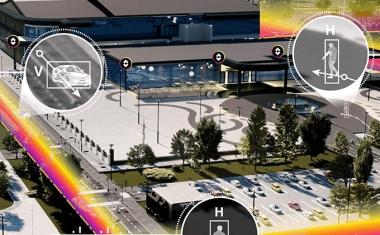Geutebruck Secures the Australian Nuclear Science and Technology Organisation

The Australian Nuclear Science and Technology Organisation (ANSTO), Sydney, recently upgraded its CCTV system. As the location of the Open Pool Australian Lightwater (OPAL) nuclear reactor, this is one of the most secure sites in Australia. More than $A3.5M in capital funding have been delivered to realize a range of security key improvements. The facility covers 70 hectares, has a 4000m perimeter and includes about 150 buildings. It is defined by legacy gear and this has defined the recent upgrade, which focused on making the system hardware agnostic as well as bringing everything into an holistic digital architecture. The digital transition has been facilitated by the installation of Geutebruck products integrating a variety of other security solutions.
The ANSTO system
The site includes a highly secure inner area containing OPAL, which is defended in depth by an outer perimeter, a sterile zone, an inner perimeter and key areas monitored with CCTV. Marcus Wiltshire, physical security advisor, explains: “Our CCTV infrastructure and platforms include Geutebruck’s G-SIM Security Information Management and Geutebruck GeViScope VMS software in a fully virtualised environment, replacing classical NVRs. It follows a distributed topology. G-Tect IVA is done at the NVR level and the G-SIM sits on top and gives you a polished VMS for alarm event management and viewing of live and recorded image streams.”
Furthermore ANSTO’s thermal perimeter is a key aspect of the site’s security solution and it incorporates a virtual thermal fence through integration with Geutebruck G-SIM and G-Tect IVA so as to maintain a single recording platform site-wide. Importantly, too, G-Tect is applied across the board to optics and thermal. “Dual sensor analytics at the recorder allow us to intelligently analyse our images in a number of environments regardless of variables like camera pole movement and yet we still get reliable intrusion detection on a day with 70kmph winds,” explains Wiltshire. According to him, G-Tect is detection within detection. “This is due to the fact you’ve got this intelligent system which allows you to define detection zones and set a particular depth of field using different parameters for a particular zone,” he explains. “This means you’ll have 30 different detection zones in one image all running at the same time. It’s robust and flexible.”
ASOC security operations centre
The upgrade to Geutebruck took just over a year. Geutebruck Australia and engineers from the headquarter in Germany have been heavily involved. ANSTO accepted a beta G-SIM so partnered with Geutebruck to assist them with development of that solution. It was a strategic partnership and ANSTO worked with them to make the system fit for purpose, as well as being fit for other users. A lot of site specific customisation has been made making daily business at the ANSTO security operations centre (ASOC) a lot easier.
The plan is open with a number of workstations arrayed in front of a very large video wall. On the workstation benches are screens that show the event log of the access control system, including intrusion events. Not surprisingly, there are a lot of cameras being displayed on the wall, covering road approaches, key entrance points and areas around the facility that need special attention.
Around the walls are digital projectors allowing key video feeds to be displayed in wall sizes. “All the site’s security operations are operated and monitored from this location. We have divided the site and the systems supporting it into 3 different security levels based on criticality and that’s how the system has been configured as well.” says Wiltshire.
According to him, their ASOC has no computers in it, instead being fed through a 20TB server, and it’s completely disconnected from the Internet. It’s got full redundancy, load sharing, there’s a mirror of this facility on site.
“The video wall is managed by Geutebruck G-SIM and allows the operators to view live image streams, view events in secure areas, undertake playback recordings, to do any investigation required to give the security team the information they need,” Wiltshire explains. “For instance, you can see the monitor on the workstation there showing the events coming in from the access control system and associated with these events are images.” He continues; “We now have the infrastructure to change whatever we need to change in the engine room – the server room – with no impact on the operators. That was exactly what we were looking for with this upgrade.” Mission accomplished...
Conclusion
ANSTO is a fascinating site and was recently rated 1 in the world for nuclear security. It’s massive, distances are enormous and it’s located in Australia’s largest city. Yet it especially has an internal culture in which security seems integral to the principles of the organisation. It’s a passion that’s reflected in the nature of the electronic security upgrade, in the level of security and flexibility offered by the Geutebruck systems and in the way both parties have worked together, not only to secure a vital facility but to improve their mutual solutions.
By John Adams, Editor, Security Electronics & Networks Magazine, Australia















